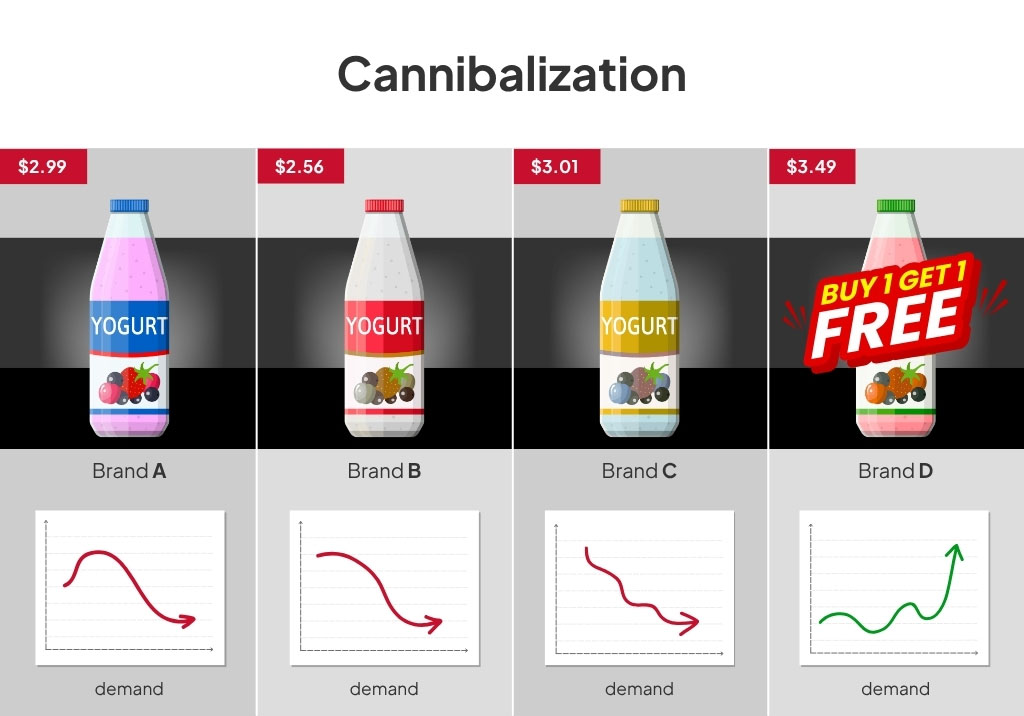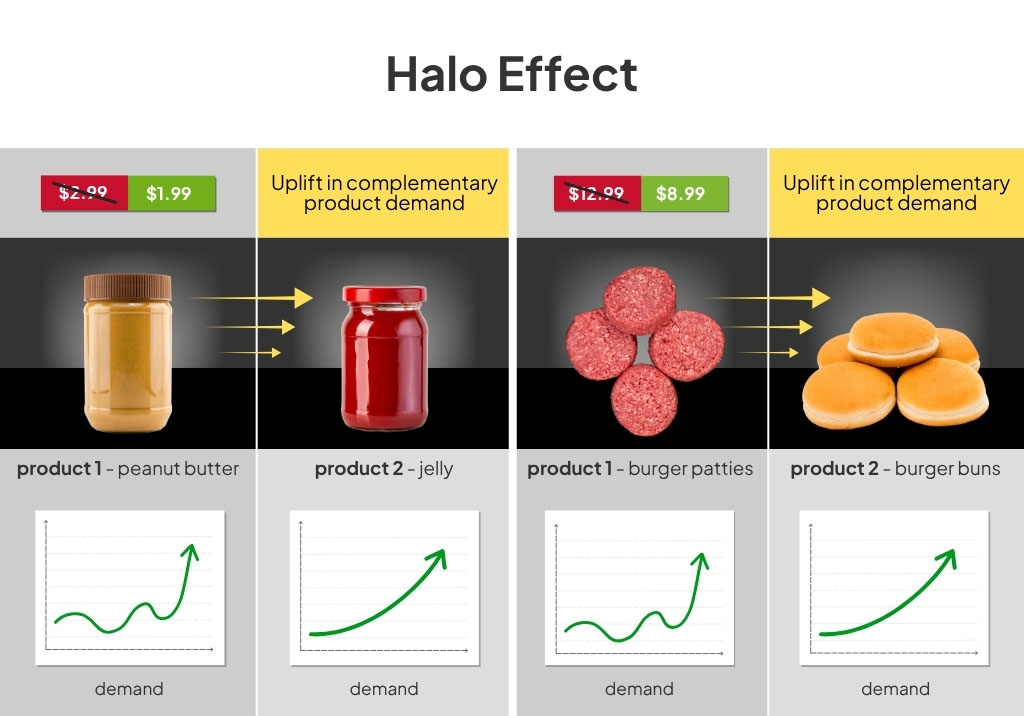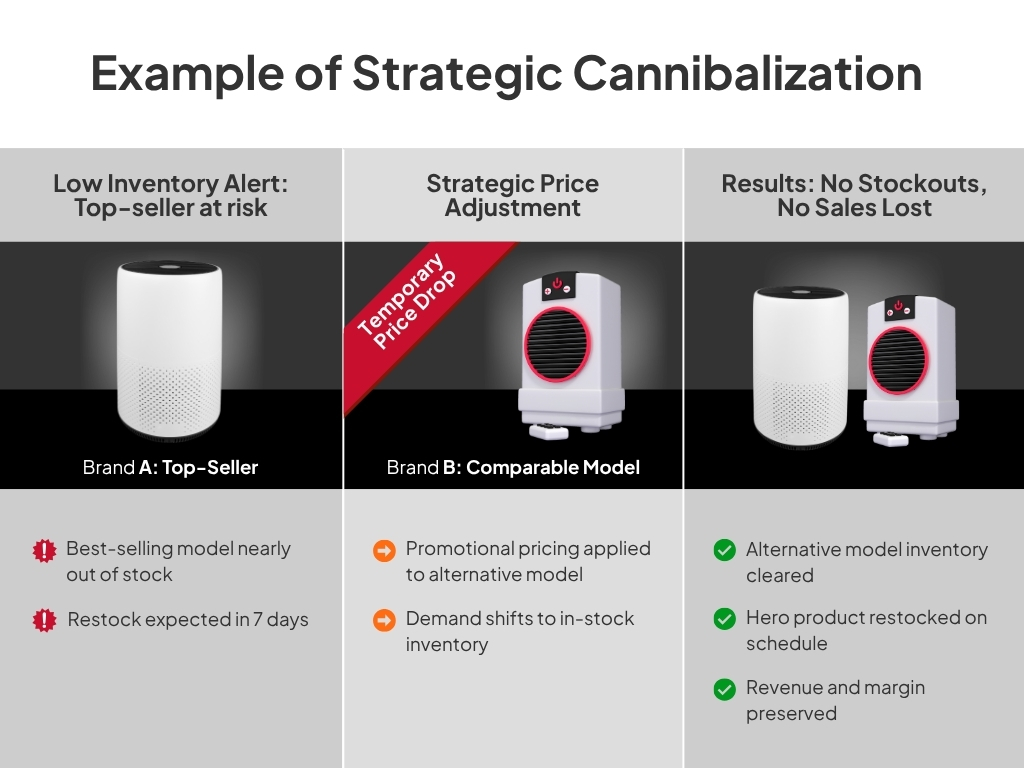Share on social
Highlights
Understanding how products interact with one another is critical for retailers looking to optimize Assortment, Pricing Strategies, Promotional Planning, and new product launches. Two key effects — Halo and Cannibalization — play a major role in shaping demand. This blog unpacks what they are, when they help or hurt, and how Churchill’s demand forecasting solutions are built to account for both.
What is Cannibalization Effect?
Cannibalization happens when the product introduction or promotional event eats into the sales of another product within the same category. Instead of generating new demand, the newer (or cheaper or better positioned) item simply shifts sales away from similar product within the assortment. Both products appeal to similar customers for similar needs, creating internal competition.

What is the Halo Effect?
The Halo effect refers to the boost in sales of a product due to the presence or promotion of another related item. This typically occurs when products are complementary or often purchased together. Rather than competing, one product lifts the visibility or desirability of another, creating a synergy that increases overall demand across the category or basket.

Negative impact of Cannibalization
This refers to unintended consequences when one product steals sales from another within the same assortment. Cannibalization isn’t inherently bad. It becomes a problem when it’s unplanned, unmanaged, or misaligned with your business goals. Here’s why:
❌ Erodes Profit Margins
If customers switch from a high-margin product to a lower-margin one — especially during a promotion — you’re making less money on the same sale volume.
Example: Selling 1,000 units of a $10 item with a 30% margin vs. a $10 item with a 10% margin means you’ve lost $2,000 in profit — just from the shift.
❌ Distorts Forecasting & Inventory
When demand shifts unexpectedly, your inventory becomes unbalanced. You may end up:
- Overstocked on the cannibalized item
- Understocked on the promoted item
- Facing markdowns, missed sales, or operational inefficiencies
❌ Doesn’t Create New Demand
You’re not expanding your market or attracting new customers — you’re just moving sales around internally. This is especially frustrating if it:
- Cannibalizes full-price items with a discount
- Undermines your brand hierarchy or product strategy
❌ Undermines Long-Term Strategy
Unintended cannibalization can derail product positioning. For instance:
- Customers get used to the lower-priced option
- Premium SKUs lose traction
- You weaken your brand tiering or pricing architecture
Bottom line: You’re not generating new demand — you’re just shifting it — often from a higher-margin item to a lower one, or from a steady-seller to a promoted item. This can hurt profits, inventory planning, and long-term category performance.
Flip side – When Cannibalization is intentional
This is about controlled cannibalization — where retailers purposely shift demand between products in a strategic way. In these situations, the retailer is fine with one product eating into another because it improves profitability or achieves other goals.
It can help with product transitions, margin balancing, or targeting different customer segments.
Example 1:
A major retailer notices that inventory for one of its best-selling air purifiers is running low, with restock expected to take over a week. To avoid stockouts and missed sales, the pricing team temporarily reduces the price of a less popular (but comparable) mid-tier model from a different brand.
The discount draws attention away from the top-selling unit and successfully redirects customer purchases to the alternative. By the time the hero product is back in stock, demand has been balanced, sales weren’t lost, and excess inventory of the slower-moving item has been cleared.

Example 2:
An electronics retailer launches a private-label version of its best-selling wireless earbuds. The new version is priced slightly lower than the national brand, but offers similar features and higher margins for the retailer.
As planned, sales begin shifting from the national brand to the store’s private label. While top-line revenue remains steady, profit margins improve because more customers are buying the higher-margin product. In this case, cannibalization is a tool for strategic margin enhancement.
Positive impact of Halo
This refers to demand boosts in related or complementary products when one product is promoted or gains attention. It’s a win-win: a promoted product increases demand, not only for itself, but also for items often purchased alongside it.
Flip side – when Halo can cause negative impact
While the Halo effect often welcomes a boost to related products, it can backfire when inventory planning doesn’t account for the spike in demand.
When a promoted product triggers unexpected demand for a related item that isn’t adequately stocked, the result can be frustrated customers, missed sales, and damage to brand perception.
Example 1:
A beauty retailer runs a high-profile campaign on a new line of facial serums. The promotion drives traffic and excitement — and leads to a sharp increase in demand for their best-selling moisturizer that’s commonly used afterward. But inventory wasn’t adjusted for the spike, and the moisturizer sold out in two days. Customers still purchase the serum, but many turn to other retailers to find the moisturizer, resulting in lost add-on sales and a missed opportunity to capture the full basket.
Example 2:
A specialty appliance store runs a promotion on a high-end espresso machine. Historically, sales of milk frothers and espresso cups spike alongside it — a clear Halo effect. But the planning team, still relying on outdated forecasting tools and static spreadsheets, only projects demand for the espresso machine itself. The accessories sell out within two days, leaving shelves empty for the remainder of the five-day promotion. The result? A missed opportunity to capture high-margin attachment sales — simply because related demand wasn’t factored into the forecast.
Example 3:
A national retailer runs a successful promotion on a top-rated vacuum cleaner that uses a custom-sized dust bag. But matching bags aren’t stocked in sufficient quantities. Customers quickly realize they can’t use the product without them — and abandon the entire purchase, resulting in lost sales, returns, and frustrated shoppers.
How Churchill’s Demand Forecasting Solutions Factor in Halo and Cannibalization Effects
Churchill’s forecasting solutions are designed to optimize the complex relationships between products — including both Halo and Cannibalization effects — so retailers can plan promotions and pricing strategies with greater accuracy and confidence.
Rather than treating each SKU in isolation, Churchill’s Cannibalization Demand Forecaster™ (CANN) detects patterns of cross-product influence, helping retailers achieve specific business goals.
Here’s how Churchill helps:
✅ Prevents Inventory Imbalances
By identifying products likely to be affected by promotions — either positively or negatively — Churchill adjusts demand forecasts accordingly to ensure shelves are stocked in the right places, at the right times.
✅ Protects Margins
Cannibalization often eats into higher-margin products. Churchill flags these scenarios ahead of time, allowing retailers to adjust pricing or promotional mechanics to protect overall profitability.
✅ Uncovers Hidden Attachments
Churchill detects subtle Halo relationships — like which accessories, ingredients, or complementary products tend to rise in demand during certain promotions — so you can stock up and capture the full basket.
✅ Optimizes Promotion Strategy
With Churchill, you can run “what-if” scenarios before launching a promotion. Understand how it might shift demand across your assortment — and evaluate whether the promotion will truly grow sales or just shuffle them around.
✅ Improves Pricing Accuracy
The software quantifies the Halo and Cannibalization impact of specific price points, helping you choose price changes that boost category performance instead of hurting it.
By factoring in Halo and Cannibalization effects as part of your unified demand planning process, Churchill gives you the visibility and control to run smarter promotions, maximize value, and minimize risk.